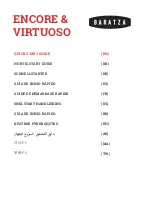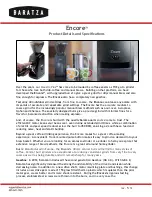
32
EnGLIsh
EC-Declaration of Conformity
Machinery Directive
Small Angle Grinders
DWE4277
D
e
WALT
declares that these products described under
Technical Data
are in compliance with:
2006/42/EC, EN60745-1:2009+A11:2010, EN60745-2-
3:2011+A2:2013+A11:2014 +A12:2014+A13:2015.
These products also comply with Directive 2014/30/EU and
2011/65/EU. For more information, please contact
D
e
WALT
at
the following address or refer to the back of the manual.
The undersigned is responsible for compilation of the technical
file and makes this declaration on behalf of
D
e
WALT
.
Markus Rompel
Director Engineering
D
e
WALT
, Richard-Klinger-Straße 11,
D-65510, Idstein, Germany
15.07.2016
WARNING:
To reduce the risk of injury, read the
instruction manual.
Definitions: Safety Guidelines
The definitions below describe the level of severity for each
signal word. Please read the manual and pay attention to
these symbols.
DANGER:
Indicates an imminently hazardous
situation which, if not avoided,
will
result in
death or
serious injury
.
WARNING:
Indicates a potentially hazardous situation
which, if not avoided,
could
result in
death or
serious injury
.
CAUTION:
Indicates a potentially hazardous situation
which, if not avoided,
may
result in
minor or
moderate injury
.
NOTICE:
Indicates a practice
not related to
personal injury
which, if not avoided,
may
result in
property damage
.
Denotes risk of electric shock.
Denotes risk of fire.
General Power Tool Safety Warnings
WARNING: Read all safety warnings and all
instructions.
Failure to follow the warnings and
instructions may result in electric shock, fire and/or
serious injury.
SAVE ALL WARNINGS AND INSTRUCTIONS
FOR FUTURE REFERENCE
The term “power tool” in the warnings refers to your mains-
operated (corded) power tool or battery-operated (cordless)
power tool.
1) Work area safety
a )
Keep work area clean and well lit.
Cluttered or dark
areas invite accidents.
b )
Do not operate power tools in explosive
atmospheres, such as in the presence of flammable
liquids, gases or dust.
Power tools create sparks which
may ignite the dust or fumes.
c )
Keep children and bystanders away while operating
a power tool.
Distractions can cause you to lose control.
2) Electrical safety
a )
Power tool plugs must match the outlet. Never
modify the plug in any way. Do not use any adapter
plugs with earthed (grounded) power tools.
Unmodified plugs and matching outlets will reduce risk of
electric shock.
b )
Avoid body contact with earthed or grounded
surfaces such as pipes, radiators, ranges and
refrigerators.
There is an increased risk of electric shock if
your body is earthed or grounded.
c )
Do not expose power tools to rain or wet conditions.
Water entering a power tool will increase the risk of
electric shock.
d )
Do not abuse the cord. Never use the cord for
carrying, pulling or unplugging the power tool. Keep
cord away from heat, oil, sharp edges or moving
parts.
Damaged or entangled cords increase the risk of
electric shock.
e )
When operating a power tool outdoors, use an
extension cord suitable for outdoor use.
Use of a cord
suitable for outdoor use reduces the risk of electric shock.
f )
If operating a power tool in a damp location is
unavoidable, use a residual current device (RCD)
protected supply.
Use of an RCD reduces the risk of
electric shock.
3) Personal safety
a )
Stay alert, watch what you are doing and use
common sense when operating a power tool. Do not
use a power tool while you are tired or under the
influence of drugs, alcohol or medication.
A moment
of inattention while operating power tools may result in
serious personal injury.
b )
Use personal protective equipment. Always wear
eye protection.
Protective equipment such as dust mask,
non-skid safety shoes, hard hat, or hearing protection used
for appropriate conditions will reduce personal injuries.
c )
Prevent unintentional starting. Ensure the switch
is in the off position before connecting to power
source and/or battery pack, picking up or carrying
the tool.
Carrying power tools with your finger on the
















































